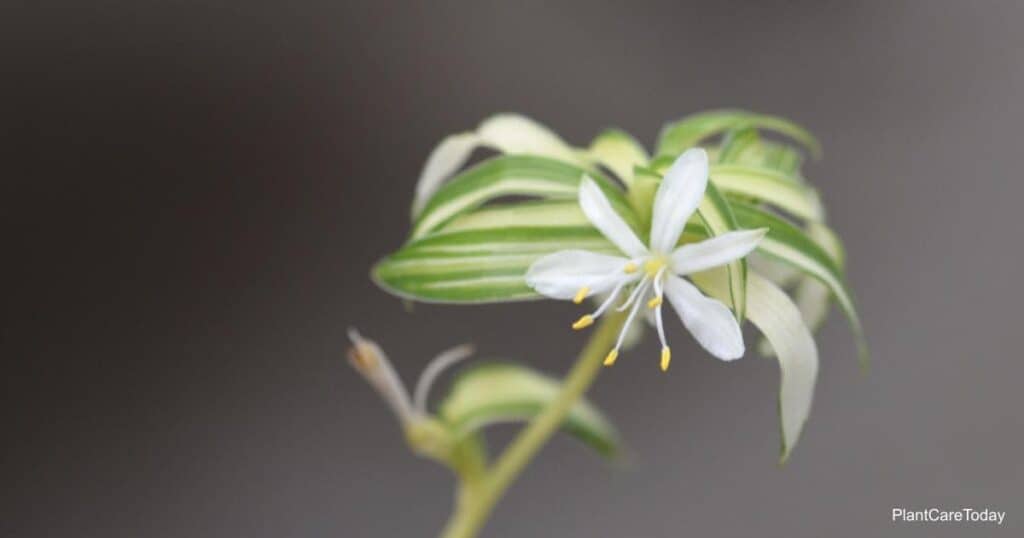It’s a surprisingly common story among spider plant enthusiasts. While doing some Chlorophytum comosum care, giving a little trim or maintenance, you notice something strange on the stems.
It can even catch the most experienced spider plant owner off-guard. Studies have shown that spider plants effectively clean indoor air by absorbing chemicals, including formaldehyde, xylene, benzene, and carbon monoxide, in homes or offices.

What is this often-overlooked phenomenon growing on your spider plant, and why doesn’t anyone talk about it?
Do Spider Plants Flower?
Spider plants do produce flowers, but their small size and simple colors usually get noticed.
Chlorophytum comosum, many people choose to call it a spider plant or airplane plant because of its lengthy leaves, which can resemble spider legs.
We love spider plants (Chlorophytum comosum) for their easy-going nature, beautiful foliage, and fast growth.
The rarity in which these plants produce flowers has also contributed to the surprise when one does bloom.
What Do They Look Like?
There’s a small variety of spider plant flowers, depending on the species.
Some will grow single flowers, while others produce loose panicles. Spider plants do occasionally develop small white flowers at the ends of their long arching stems.
Each flower sports between 3 and 6 petals measuring .2″ to .4″ inches long.
The flowers are most often white, but some species have greenish-white or yellow flowers instead.
These blossoms are often described as interesting but insignificant, which is part of the reason why they often go unnoticed.

These flowers turn into spiderettes that can be cut off and planted as individual plants.
Let’s take a look at what spider plant flowers are and how to encourage their growth.
The inflorescence will most usually appear on rapidly growing stems but may also appear on the tips of existing stems.
Related: Check out the: Bonnie Curly Spider Plant
When Do Spider Plants Flower?
Spider plants bloom in such variances that it’s hard to know when to expect them.
For a few spider plant varieties, blooms may occur in younger plants but will become less likely with age.
If you have a mature specimen and you’ve never noticed or known that they can produce flowers – until now – that’s possible because of these houseplants’ possible low maintenance; you’ve missed the short-lived spider plant blooms in the past.

In most species, you may notice spider plant flowering when they are older.
The indoor flowering period may occur in spring or summer, as the more regulated temperatures can confuse new plants.
Blooms are very short-lived, and the succession of tiny flowers will sparsely accent your flowering spider plant for only a few weeks.
However, you would have to wait to witness flowering if the maturity is reached by winter, and the plant will usually grow flowers in the next blooming season.
Does The Spider Plant Flower Have A Fragrance?
One of the reasons spider plant enthusiasts don’t mention or even notice the flowers is their total lack of scent.

These plants are not known for attracting any form of pollinator and appear to only be decorative.
In reality, the flowers do give way to viable seeds that may propagate.
Likewise, the spider plant bloom gives way to spiderlings one can transplant to new pots.
Tips On Getting Your Spider Plant To Flower
Getting a spider plant to groom takes more effort, and there are a few environmental conditions you’ll want to watch.
The closer you can get your spider plant to ideal conditions, the better the chance it will bloom.

Never stress your plant by allowing it to dry out frequently. Overly dry soil will cause the leaves to turn brown and die back.
Tip burn of the leaves is a common problem that can have many causes. Low humidity, excessively dry soil, salt accumulation, and/or chemicals, particularly fluoride or chlorine, in tap water may cause brown leaf tips. Using distilled or rainwater will help prevent tip browning.
Here are three factors that play a crucial role in spider plant blooming.
Roots
Spider plants, especially older ones, are more likely to bloom if they’re slightly root-bound.
Related: More on root-bound spider plants.

For those who may not be familiar with gardening terminology, when a plant is “pot-bound,” it refers to the fact that the roots no longer have anywhere to go and begin taking the shape of the pot it’s in.
It commonly occurs when plants are put into small pots when they are young and are never moved to a larger pot to accommodate the growing root system.
When they are young, some spider plant species constantly bloom, making them a sight to behold for any plant enthusiast.
This sends a signal to the plant that it needs to reproduce and spread to other areas, as it has limited space to expand.
Light
Try to keep your spider plant in bright, indirect sunlight and turn the plant occasionally to ensure all sides get equal light.
A temperature that is too high or low will affect the flowering, whereas low humidity will affect the plant’s health.

Increase the amount of light during summer, and decrease it in winter to mimic outdoor conditions.
Provided it’s receiving enough light and warm temperatures, keep an eye on it, and you may just see some of those little blooms appearing on the arching stolons!
Related: More on Growing Spider Plants Outdoors
Fertilizer
Spider plants don’t need a lot of fertilizer to thrive, and too much will reduce the chances of flowering.

Use a low-strength fertilizer that provides a 2-4-4 or 4-4-4 NPK ratio.
Before you fertilize, check out these tips on watering your spider plant.
You may choose to use a fertilizer that encourages blooming during spring feeding, but make sure it remains at a low dose.
